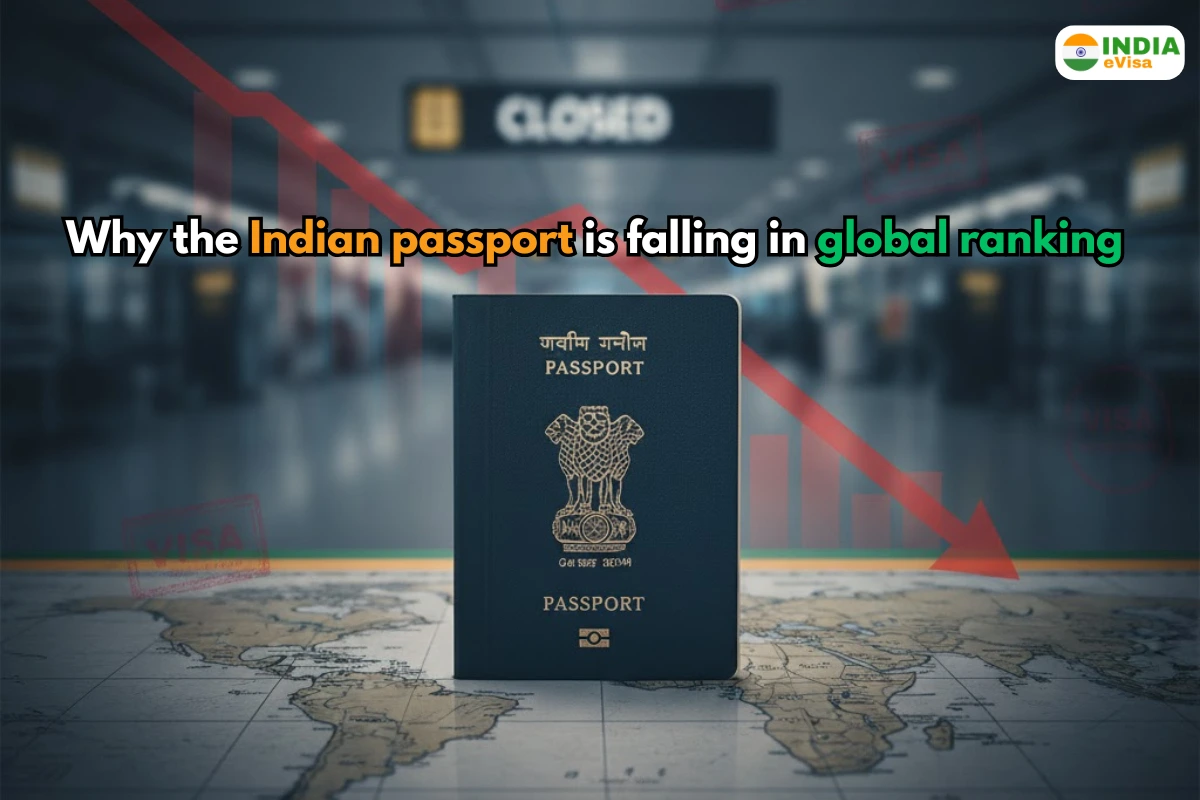Why the Indian passport is falling in global ranking

If you’ve felt more visa checks, longer application forms, or fewer places you can travel without planning ahead, you’re not alone. The Indian passport has seen ups and downs in the world rankings recently, and that affects millions of people who travel for work, study, or holiday. In this article I’ll explain clearly and kindly what is happening, why it matters, and what travellers should do — including how to use systems like india evisa and india visa. I’ll also add the common link phrases India Visa Online and India Visa Information inside the article so readers and site owners can easily connect to official pages.
What the numbers say — short answer
In the latest Henley Passport Index update, India’s position slipped compared with the previous year. The official Henley list shows India lower in the 2025 ranking than it was a year before. This means the Indian passport now gives visa-free or visa-on-arrival access to fewer countries than earlier.
How passport rankings are counted (easy)
Passport rankings are not about pride — they are simple counts. Indexes check how many countries a passport holder can enter:
- visa-free (no permission needed in advance),
- visa on arrival (get permission when you land), or
- eTA/eVisa (apply online before travel).
If a passport can enter more countries without a visa, it ranks higher. If other countries make new visa deals with one another, they can rise faster. So sometimes the Indian passport falls not because India did worse, but because other countries made more deals between themselves.
Main reasons the Indian passport has fallen
Here are the main reasons, written simply so everyone can understand.
- Other countries made new visa agreements
Passport power is relative. When groups of countries sign visa-free deals inside their region, their passports jump up. Even if the Indian passport stays the same, others can overtake it. - Changes after the pandemic and security upgrades
Many countries tightened entry rules, added electronic checks, or changed their visa lists after COVID-19 and for security reasons. Some places reduced visa-free access or started requiring more checks for certain nationalities. This can reduce the number of countries an Indian passport can enter without planning. - Diplomacy and reciprocity matters
Visa deals are diplomatic. If a government does not prioritise travel mobility in talks with other countries, visa-free access grows slowly. Countries that actively negotiate mobility see faster improvements. - Passport technology and document standards
Many countries now ask for biometric, chip-enabled passports or specific security features. India has started issuing new chip-enabled e-passports in phases, which helps, but until these are widespread, some automated entry systems may not accept older documents. - Different index methods and timing
Different passport indexes count things slightly differently. Some treat eVisa and eTA the same as visa-free; others separate them. Also, rankings change each time indexes update, so headlines can seem confusing if you look at different lists.
What this means for regular travellers
If you hold an Indian passport, the practical effects are clear:
- You may need to apply for more visas in advance.
- For many countries you will use india evisa systems — that means an online form and an electronic permit before you travel. Check each country’s rules carefully.
- Short business trips may need more planning because visa processing can take time and money.
- Always check the exact rules on official sites and use pages titled India Visa Online or India Visa Information for step-by-step guidance.
Quick, practical tips for travellers
- Check the Henley list or official government pages before booking major plans.
- Use the official Indian e-Visa portal when you need to come to India, and beware of fake sites — the government warns that the correct site is indianvisaonline.gov.in. If you are applying from abroad, check your nearest Indian embassy page for clear India Visa Information.
- Keep digital copies of passport pages and visa receipts.
- Apply early for a visa rather than waiting for last-minute approvals.
- Consider services only from trusted providers and check reviews.
A human note — the real cost behind the numbers
Numbers and ranks can look like an abstract list, but the effect is very real. Imagine a student who wins a study seat but faces extra visa delays, or a small business owner who loses a client because a short trip needs a long visa process. These everyday losses are why people feel upset when the Indian passport drops in a list. It is not just statistics — it affects jobs, family plans, and dreams. Humans feel frustration, and that’s valid.
What India (and citizens) can do
- The government can keep negotiating visa deals, invest in passport technology nationwide, and make travel diplomacy a priority.
- Travellers can stay informed, use official portals for india visa queries, and plan trips earlier. For those running travel sites, put clear links like India Visa Online and India Visa Information so readers find the right help fast.
Final thoughts — simple and clear
The fall of the Indian passport in recent index updates is a mix of global changes, regional diplomatic moves, and evolving security rules. That means Indian travellers need a little more planning today than they might have before. Use verified sources, apply early, and keep your documents ready.
